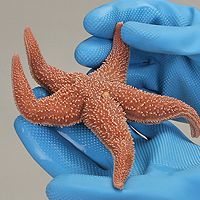My Cart
Your Shopping Cart is currently empty. Use Quick Order or Search to quickly add items to your order!

The sea star, or starfish, is a marine invertebrate belonging to the phylum Echinodermata (from the Greek for spiny skin). It exhibits radial symmetry, with 5 arms extending from a central disk. Introduce your students to the external anatomy of the sea star using the dissection guide below and explore the interesting structures that function in protection, locomotion, and feeding.
Now your students are ready to learn about the sea star’s internal anatomy—and Carolina’s Starfish Dissection BioKit® is a great resource to teach the anatomy of this echinoderm. The kit includes 30 starfish, 30 self-locking storage bags, 30 student guides, and a teacher’s manual.